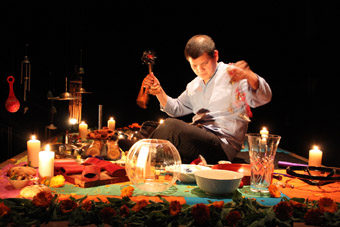music for the quick and the dead
chris reid: evaristo aguilar & aphids, xantolo

Evaristo Aguilar, Xantolo
photo Thea Baumann
Evaristo Aguilar, Xantolo
I AM IN THE FIRST COHORT OF PEOPLE TO WITNESS THE WORLD PREMIERE PERFORMANCE OF XANTOLO. TWENTY OF US ARE SEATED IN A SINGLE ROW ON THREE SIDES OF A LOW PLATFORM, IN THE MIDDLE OF WHICH SITS MEXICAN PERCUSSIONIST EVARISTO AGUILAR SURROUNDED BY AN ARRAY OF PERCUSSION INSTRUMENTS, FLOWERS, CANDLES AND BREAD.
Xantolo means day of the dead in the Huastecan language of Mexico and, for Mexicans, the Day of the Dead is an annual holiday of remembrance of deceased relatives and friends. This is the first of five performances on November 2, a day which marks All Souls Day in the Catholic Church and the second of the two traditional days of Mexican observance.
Following a taped introduction outlining the origins of the work, Aguilar begins to play the percussion instruments—wooden blocks and tubes, brass bowls and plates, small cymbals, drums, rattles, metal and wooden chimes and found porcelain and glass bowls. He plays gently, almost caressingly, using drumsticks or his hands, each instrument making carefully tuned resonant tones, and he pours dried grains of corn to create a percussive sound. The 15-minute performance appears ritualised, as if we are being led through prayer or meditation, and the dance rhythms are hypnotic. Limiting the audience to 20 allows an uninterrupted view of the performer and also enjoins audience members as an extended family group sitting closely around the table. The instruments are simple and beautiful and some are symbolically suggestive—the bowls represent the home and corn is a staple food—while others have been designed by Aphids artist Rosemary Joy specifically for this work, evoking the kinds of sounds heard on such occasions and perhaps the spirits of the dead themselves.
This production continues Aphids’ long-established concern with collaborative and cross-cultural performance. Evidently, Joy visited Mexico and witnessed Day of the Dead celebrations in Huastecan culture, which combine pre-Columbian and Catholic traditions, and which are typically festive occasions, with participants in costume singing and dancing, and a table or altar in each home set with flowers, bread (pan de muerto), rosaries and candles. A structured improvisation, the work is part percussion performance and part theatrical presentation, an abstraction of certain characteristics of Huastecan Xantolo celebrations, though perhaps more muted and internal. A window into another culture, it is thus a mirror onto our own.
The Melbourne Recital Centre has on its web-site an interview between its CEO Jacques de Vos Malan and Rosemary Joy and Aphids artistic director David Young discussing the origins of the work. Placed in this context, the performance becomes much more than a fine percussion piece. Aguilar, a professor of percussion in Mexico, has adapted traditional Huastec musical forms for presentation internationally. The Melbourne Recital Centre has taken a bold step in supporting a work with a radically different form of presentation, limiting the audience to 100 in five shifts, but the intimacy and close attention afforded are vital to understanding and appreciating this absorbing work.
Xantolo, percussion Evaristo Aguilar, artist Rosemary Joy, instrument construction Adam Stewart, Rosemary Joy, producer Aphids; Melbourne Recital Centre, Nov 2
RealTime issue #94 Dec-Jan 2009 pg. 46






